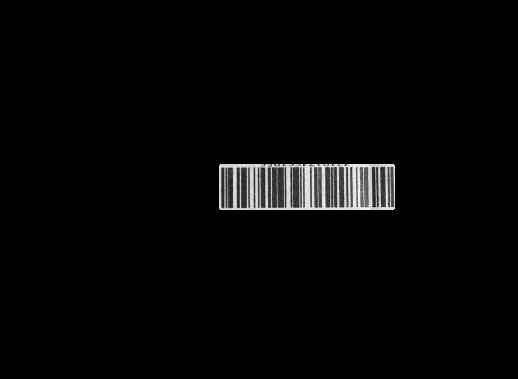halcon——条码定位与识别(一维码)
引言
条码识别的应用大多数在物流行业中(需要识别的条码一般在快递包裹中),对于一维码的识别,halcon有自带条码识别算子create_bar_code_model和find_bar_code 。而快递标签处有很多的文字,符号和边框,增大了定位的难度。,因此有时也有检测不到条码的情况。针对这一现象,本篇就来深度分析一下如何更好的去识别一维码。
一,相关算子分析
-
create_bar_code_model(创建一维码模型)
create_bar_code_model ([], [], BarCodeHandle) 参数一//输入 需要调整的参数名称(为[]表示暂时不设置) 参数二//需要调整的该参数的值。 参数三// 返回的条码模板句柄
- set_bar_code_param(对模型设置参数)
set_bar_code_param( BarCodeHandle, GenParamNames, GenParamValues ) BarCodeHandle(in)//模型句柄 GenParamNames(in)//参数名称 GenParamValues (in)//参数值
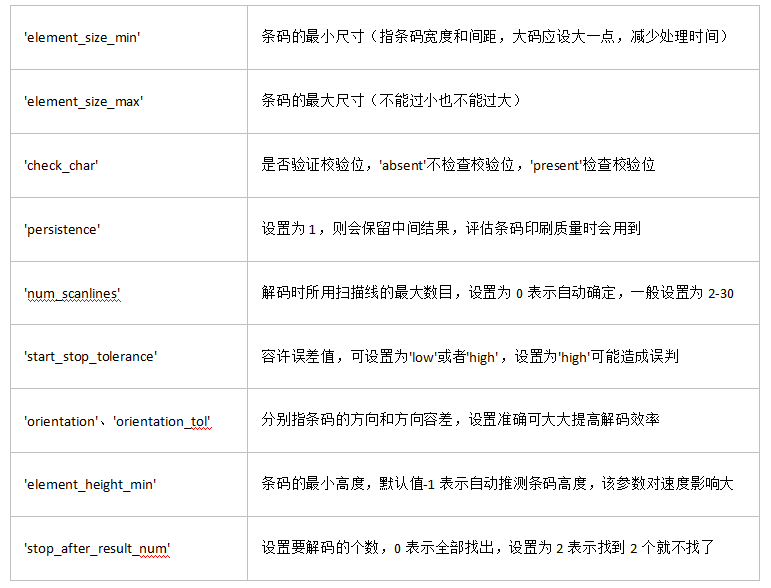
-
find_bar_code (识别一维码)
find_bar_code(Image ,SymbolRegions ,BarCodeHandle, CodeType , DecodedDataStrings) 参数列表: Image //输入图像 SymbolRegions//检测到的条形码区域(输出) BarCodeHandle// 条形码句柄 CodeType// 条形码类型 DecodedDataStrings//识别结果(输出)
二,提高解码能力的其他措施
(1)图像预处理(增强条码)
- 对比度太低:scale_image(或使用外部程序scale_image_range),增强图像的对比度。
- 图像模糊:emphasize锐化图像,使条码看起来更清晰。
- 深色背景上读取浅色条码:invert_image反转图像。
(2)如果整张图信息太多,则可以先把条码区域挖出来,使用reduce_domain和crop_domain算子,这样不仅可以降低解码难度,还可以减少解码时间。也可使用decode_bar_code_rectangle2在指定的矩形区域内解码。
(3)当条码很密或者很小的时候,可以尝试用zoom_image_factor放大了条码图像。
(4)find_bar_code中将“CodeType”设置为“auto”可以读取多种类型的条码,但是会增加运行时间,且可能会降低解码的可靠性。最好只扫描预知的条形码类型。
三,如何在图像提取条码区域
以快递上的一维码为例,由于快递标签处有很多的文字,符号和边框,增大了定位的难度。(如下图)而且有很多噪声的影响。
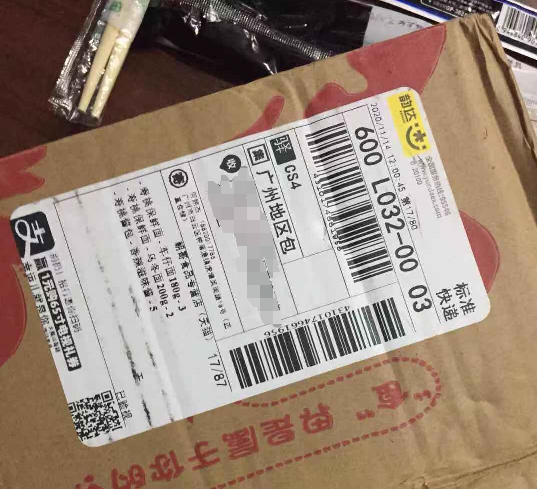
halcon实现:
1,读入图像,提取轮廓
有两种方法:
- 基于边缘提取
- blob分析
read_image (Image, 'C:/Users/86175/Desktop/4.png') get_image_size (Image, Width, Height) dev_open_window (0, 0, Width/2, Height/2, 'black', WindowHandle) dev_display (Image) rgb1_to_gray (Image, GrayImage) *第一种边缘提取初步提取轮廓 laplace_of_gauss(GrayImage, ImageLaplace, 2)//拉布拉斯算子 threshold(ImageLaplace, Region3, 5, 127) skeleton(Region3, Skeleton3) connection (Skeleton3, ConnectedRegions2) select_shape (ConnectedRegions2, SelectedRegions, ['area','width','height'], 'and', [0,0,0], [220,80,200]) *第二种Blob分析法初步提取条码 threshold (GrayImage, Regions, 7, 107) connection (Regions, ConnectedRegions)

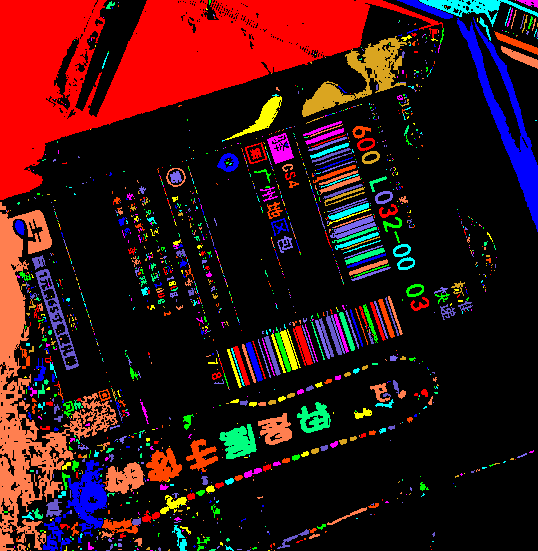
二者提取效果差不多,但是考虑到Blob分析法可能对相机像素有较大的要求,否则二值化后可能提取不出条码线,个人觉得用边缘提取的方式较稳定。
2,筛选条码区域
*通过面积和矩形度筛选 select_shape (ConnectedRegions, SelectedRegions1, 'area', 'and', 60, 1500) select_shape_std (SelectedRegions1, SelectedRegions, 'rectangle2', 60) *提取轮廓 union1 (SelectedRegions, RegionUnion) skeleton (RegionUnion, Skeleton4) gen_contours_skeleton_xld (Skeleton4, Contours1, 1, 'filter') *通过轮廓长度过滤小噪声 select_contours_xld (Contours1, SelectedContours, 'contour_length', 30, 200, -0.5, 0.5)
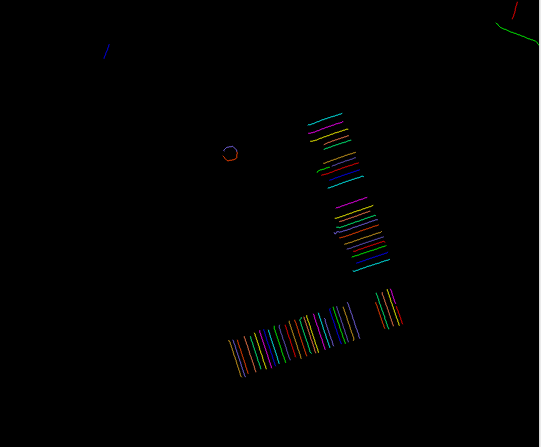
3,拟合直线,进一步筛选
*因为条码都是直线,可以通过角度相同的直线分割条码 *拟合直线 fit_line_contour_xld (SelectedContours, 'tukey', -1, 0, 5, 2, RowBegin, ColBegin, RowEnd, ColEnd, Nr, Nc, Dist1) *画拟合线 gen_region_line (RegionLines1, RowBegin, ColBegin, RowEnd, ColEnd) *在0~-180°里每-30°查找一次条码 for i:=-1 to -150 by -30 select_shape (RegionLines1, SelectedRegions3, 'phi', 'and', rad(i-30), rad(i)) count_obj (SelectedRegions3, Number) if(Number>12) union1 (SelectedRegions3, RegionUnion1) area_center (RegionUnion1, Area1, Row, Column) orientation_region (RegionUnion1, Phi) if(Phi>rad(90)) Phi:=Phi-rad(180) endif if(Phi<-rad(90)) Phi:=rad(180)+Phi endif vector_angle_to_rigid (Row, Column, Phi, Row, Column,rad(0), HomMat2D) affine_trans_region (RegionUnion1, RegionAffineTrans1, HomMat2D, 'nearest_neighbor') affine_trans_image (GrayImage, ImageAffineTrans, HomMat2D, 'constant', 'false') closing_rectangle1 (RegionAffineTrans1, RegionClosing, 80, 2) connection (RegionClosing, ConnectedRegions1) select_shape (ConnectedRegions1, SelectedRegions4, 'area', 'and', 2954.26, 50000) shape_trans (SelectedRegions4, RegionTrans, 'rectangle2') region_features (RegionTrans, 'width', w) region_features (RegionTrans, 'height', h) if(w/h<2.5 or w/h>10) continue endif reduce_domain (ImageAffineTrans, RegionTrans, ImageReduced1) threshold (ImageReduced1, Regions1, 160, 254) area_center (Regions1, Area, Row1, Column1) threshold (ImageReduced1, Regions2, 0, 120) area_center (Regions2, Area2, Row2, Column2) if(Area>Area2) if(Area/Area2>2) continue endif endif if(Area2>Area) if(Area2/Area>2) continue endif endif dilation_circle (RegionTrans, RegionDilation, 6) reduce_domain (ImageAffineTrans, RegionDilation, ImageReduced) endif endfor
